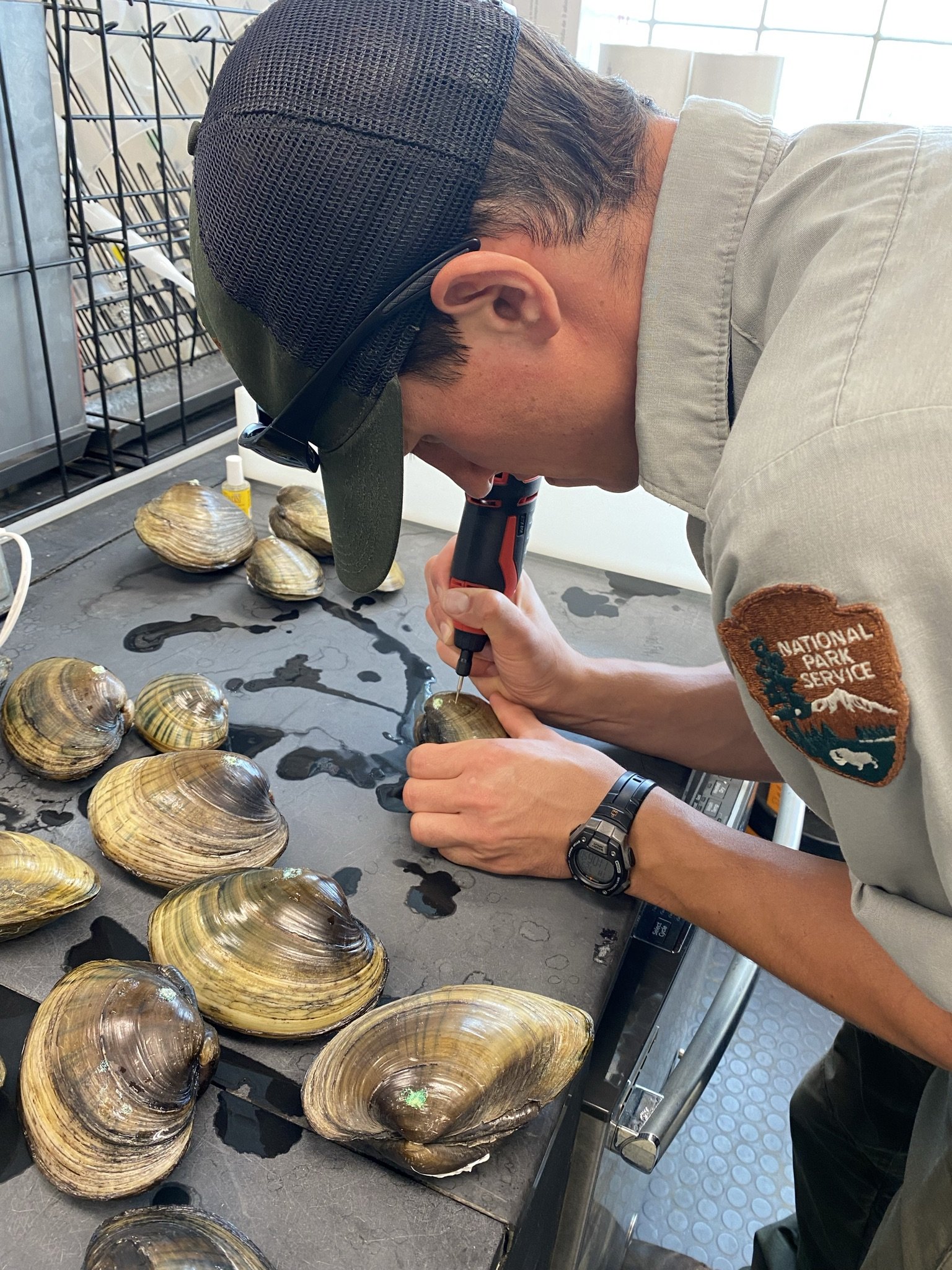Northwest Indiana Ecologists Restore Native Mussels to Little Calumet River
In northwest Indiana along the East Branch of the Little Calumet River, ecologists are working to restore populations of native mussels, an often-overlooked natural resource that improves water quality in tributaries off Lake Michigan.
“We drink Lake Michigan,” points out Dan Plath, chief of resource management at Indiana Dunes National Park, where the research is taking place. “One of the largest sources of contamination to Lake Michigan is our tributaries, and if we can get mussels in there to help filter it, it’s ultimately having a human positive effect on the wider ecosystem.”
Park staff have identified 18 species of mussel that once thrived in the river, but recent surveys of the East Branch identified only two remaining. One, called ellipse, is a hold-out of a remnant population that only exists in one small tributary, and the other, white heelsplitter, appears to be a small, sporadic natural reestablishment that took place more recently.
“This river is an anomaly in Indiana, because normally, you’d find something more here,” says ecologist Dr. Charles Morris, who is spearheading the restoration efforts. “The existing habitats and water quality are similar to adjacent watershed where these mussels thrive.”
Why the difference? Theories include pesticides and herbicides, sewage treatment plants, and the widespread clearing of wetlands, but none of these can be confirmed by examining the shells the mussels left behind. Instead, Morris and his colleagues are combating the losses by restoring three species of mussels to the river. If successful, this project could help reduce bacteria, filter water, and provide more diverse habitat, among other benefits.
With funding from the Great Lakes Restoration Initiative and partners like the Indiana Department of Natural Resources and the U.S. Fish and Wildlife Service, Morris and his team began by evaluating factors like habitat suitability, reproductive success, and species resiliency before deciding to target plain pocketbook, fatmucket, and white heelsplitter as three species most likely to survive reintroduction.
“We established a suite of mussels that we feel are pretty tolerant and therefore most likely to establish a foothold quickly,” Morris explains. “We’re just looking at mussels that we feel would be successful in the river, with an idea that any native mussel is a good mussel at this level.”
National Park Service Biologist Adam Derkacz tagging plain pocketbook (Lampsilis cardium) for translocation into the East Branch of the Little Calumet River.
Last year, the program raised about 1,500 mussels to a target size of 1.5 millimeters before placing them in cages in a lagoon off Lake Michigan for “overwintering.” If all goes well, they’ll be tagged and introduced to the river.
“We’re waiting for August, when we’re going to pull those cages out of the lake,” Morris says. “We’re optimistic that we’ll see a nice return.”
Reintroducing the mussels has been a process of trial and error. Currently, Morris is running the operation out of a building on the park campus, which doesn’t provide access to the river. Without the water that the mussels will eventually live in, the team has wrestled with basic well water, high levels of unionized ammonia, and nearly daily water changes. If not carefully monitored, a mistake can decimate an entire tank of 3,000 mussels in as little as 24 hours.
In order to get the mussels closer to the river, Morris obtained a grant from the Great Lakes Restoration Initiative to build out a 24-foot mussel rearing trailer based on a design by Genoa National Fish Hatchery. The hope is that this trailer will be able to pump water directly from the river, accommodating multiple tanks with the potential to handle several thousand juvenile mussels. After troubleshooting, the trailer could increase survival rate from the current 30% to as high as 70%. Morris estimates that the trailer will cost about $125,000 by the time it’s fully outfitted—a process that’s still underway.
For a restoration project like this one, where grant applications are competitive, Morris is giving serious thought to the future.
“We’re okay in the short term,” he says. “But how do we sustain the program to ensure we meet our targets 10 years out? Because it really is that kind of commitment, otherwise you’re wasting your time. You simply can’t get to your end game in three years. You just can’t produce enough animals.”
The program has set an ambitious restoration goal of releasing 100,000 individual mussels over the next 10 years. “While existing hatcheries are capable of propagating mussels, an order of this size isn’t logistically possible as a short-term solution,” says Morris. “It’s difficult for these hatcheries to support long-term restoration efforts when they have their own restoration goals. Additionally, at a price of $10-$20 per mussel, the best path forward was to use cost-effective, adaptive strategies for restoring mussels right here at the park.”
Morris is hopeful that future funding will allow him to bring on additional experienced staff members to help expand the project and spread the word about its importance. “If you get outside this region, there aren’t a lot of people who are going to worry too much about the East Branch of the Little Calumet River,” he says. “This is our job here with the Indiana Dunes National Park. This is our mandate to preserve and protect this river. It has restoration potential, and we’re committing ourselves to that path.”

